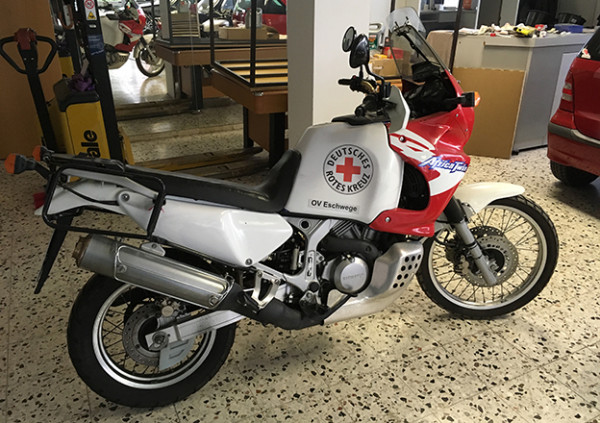Mirko Dölle, journalist, has already used our FOLIATEC.com spray film twice to transform his private motorbike into a Red Cross motorbike - and back again.
His story shows not only the preparations for painting, but also how well the FOLIATEC.com spray film can be removed again.
According to Mirko, the result after assembly is impressive.
We agree, but see for yourself and read Mirko's story:
For the Open Flair 2014, I transformed my white-red-blue African into a Red Cross motorbike for the first time. Not permanently, of course, as I didn't want to donate my African to the Red Cross, but only use it temporarily for the event. To do this, I painted the blue tank and the side covers white with spray film from Foliatec and then used the motorbike as a service bike at the Open-Flair campsite - the ideal place for an Enduro. There it proved to be a very useful reconnaissance and guidance vehicle.
Striptease
A Red Cross motorbike has to be painted red and white, of course, if it is to be used officially on duty. Of course, this is not possible with a predominantly blue machine:
I was lucky: I didn't have to change the white mudguard at the front and the white rump at the back, and the red engine and tank fairings also fit in well with the colour scheme. The blue tank and the blue side panels don't work at all, so they had to be painted and removed:

Taped off and fire at will
I cleaned the tank and the side panels with alcohol and then masked off areas like the tank opening and the brackets for the front fairing with masking tape. The masking tape should be of good quality, saving money here will pay off when the film creeps under the tape at the edges and cannot be removed again due to insufficient coverage.
After that, it's time to paint. I used the Foliatec spray film set in white for 39.90 euros at the time. Don't be fooled by the amount of paint: I needed two cans of spray paint for the tank and more than one for the side panels. It is important to apply several coats in quick succession and not to wait too long.
The first coat does not cover completely, you can still see the original colour shimmering through. Let the spray film dry for about three to five minutes, but do not let it dry completely.
Then apply the second coat, which will slightly dissolve the first one and cover it completely. Again, let the film dry for 3-5 minutes.
The third coat covers the last thin spots and builds up the thickness of the film. This is crucial because you need at least three, preferably four layers of film so that it can be peeled off in one piece later. If you are too economical and think that two layers are enough, you will be surprised when you try to remove the film. This can only be done with solvents.
That's why I applied a fourth coat of film after a few minutes' rest. At the beginning it is a bit difficult to tell when drops start to form, but as time goes by you will be able to tell from the still damp surface whether a paint nib is about to form or whether you can still apply some paint. If a nib forms, soak it up as soon as possible with a piece of kitchen towel so that it does not run over the entire painted surface.
Remove the masking tape
As soon as you put the spray can down, remove the masking tape as soon as possible while the film is still wet. As a precaution, you should also have a cutter knife or scalpel at hand.
The background is that the spray film forms a surface over the edge of the masking tape. If you pull off the masking tape later, when the film is already dry, you will pull off the entire paint film. This usually does not happen when the film is wet - and if it does, cut the piece of film with a scalpel.
The cohesive power of the spray film over edges also guaranteed that stickers like those on the side panels of my motorbike could stay on and still disappear under the paint film. The result after assembly is impressive:

Later, I stuck stickers either directly onto the paint film or onto magnetic film.
Liability question
A frequently asked question is how well the spray film holds. Very well, I have to say. You can hose it down with a high-pressure cleaner without hesitation, nothing will happen. I was even able to peel the Red Cross stickers off the film again without it coming off the original paint.
A few months later, I pulled the film off again. The main problem was to find a start and then pull the film off in large pieces. Especially in the thinner areas it didn't work so well. Spray is the biggest nightmare, you can only get rid of it with solvent.
Peeled off
At the beginning of the refugee crisis, I repainted the bike into a Red Cross bike again in August 2015. This time it stayed in the Red Cross look for almost two years before I changed it back again in July 2017:

The side panels proved to be relatively unruly because the film kept tearing at the edges of the stickers and at the recesses. Nevertheless, it could be removed completely. It was even easier with the tank, where I easily pulled off the film in large shreds. It wasn't even necessary to remove the tank. The tank opening, on the other hand, was problematic, as it was only possible to pull it off shred by shred:

Finally, I rubbed the tank and side parts with alcohol to remove the last shreds. Since then, my African has been restored to its original colour:

Click here for the original article by Mirko Dölle.
Click here for our spray films in the online shop.




















